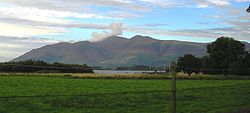| Cumbria Way | |
|---|---|
 Waymarker and logo | |
| Length | 112 km (70 mi) |
| Location | Cumbria, England |
| Established | 1970s |
| Trailheads | Ulverston Carlisle |
| Use | Hiking |
| Elevation gain/loss | 2,973 m (9,754 ft) |
| Highest point | High Pike, 658 m (2,159 ft) |
| Difficulty | Challenging |
| Season | All year |
| Waymark | Name on green disc |
| Website | www |
The Cumbria Way is a linear 112-kilometre (70-mile) long-distance footpath in Cumbria, England. [1] [2] [3] The majority of the route is inside the boundaries of the Lake District National Park. Linking the two historic Cumbrian towns of Ulverston and Carlisle, it passes through the towns of Coniston and Keswick. The route cuts through Lakeland country via Coniston Water, Langdale, Borrowdale, Derwent Water, Skiddaw Forest and Caldbeck. It is a primarily low-level route with some high-level exposed sections. [4]




